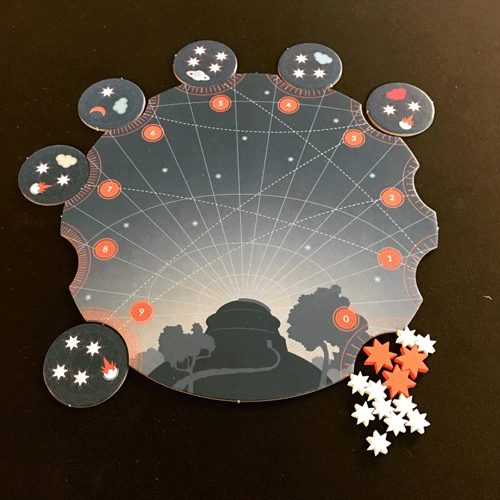StarFall Review
on Jan 17, 2017
When a game is described as “overproduced†I usually imagine piles of plastic miniatures, stacks of cards, and superfluous player aids. The dungeon-crawling-monster-fighting game underneath all that stuff can’t support it and I’m left feeling like I ate 1,000 empty fast food calories after wards. StarFall has none of that stuff yet left me feeling the same way.
The presentation is delightful; the board and tiles make a beautiful minimalistic display of cool muted colors that draw you into StarFall’s superfluous theme. Players are astronomers with their telescopes pointed at the night sky hoping to acquire sets of various astronomical phenomena. Colorful nebulae, moons, planets, and more decorate the tiles you’re hoping to collect as they cascade down a striking board. The art direction here is striking; it’s just the only part that is.

StarFall is a very pretty game
StarFall uses a “Dutch Auction†auction system is a little interesting at first. Tiles start very expensive and will come down in price over time. Allowed to move around the board long enough and they may even become free, though that will rarely happen. What usually occurs is someone buys up the tile, unwilling to let it fall further in price at the risk of someone else snatching it up. There are a few ways to lose points, adding an ever so slight layer of risk to the evening as well. You’ll never get any additional currency - colorful wooden stars – so every tile obtained reduces future purchasing power. That can be a big deal late in the game.
It’s rather simple to teach and play as you only ever have 2 or 3 options. Add new tiles to the display (up to 3), make one of them cheaper, or buy something. It’s a delicate dance between pushing something so cheap that you don’t get it and buying too soon and losing an opportunity at later tiles. With two players it’s a game of chicken but with any more it feels more like you’re helping your opponents than you are yourself. While there is rarely the opportunity for a power play, getting your opponents to set you up for tile while you sneakily collect comets is fun in a quiet way.
Unfortunately, while the auction system is unique and interesting, the actual resolution of the game is a rather bland and uninspiring set collection exercise. Other than Moons needing Planets to be able to score, nothing really integrates with the setting at all. The art is pretty, but it’s effectively arbitrary symbols worth some arbitrary though mathematically balanced point value. Never has there been any excitement or drama beyond a quiet “Aw man I wanted that†followed by some tallying a few minutes later. Losing doesn’t feel particularly bad, though winning doesn’t feel particularly good either. Both feel like the inevitable conclusion of the 30 minute game.
That isn’t to say StarFall is bad just that it isn’t compelling. It’s $10 wine in a $20 bottle, and – as my post-holiday recycling bins show – there is often occasion to bring that out. StarFall’s aesthetics draw people in and it teaches and plays in a time frame very friendly to new players. I played numerous games with family over the holiday and we enjoyed them all. It’s notable however, that no one ever really asked to play it again. Everyone is happy to play when it’s suggested, but given a pile of games to choose from it was never the first or second choice.
While it may not attract seasoned board gamers to the table, it certainly won’t repel friends and family who have yet to see the light. StarFall is the epitome of games that do nothing to either recommend or disqualify themselves from inclusion on a shelf or game table. This also makes it extremely difficult to recommend. It’s fine, but there are lots of fine games out there.

 Customer Support
Customer Support  Subscribe
Subscribe 




 Account
Account  Wishlist
Wishlist 
